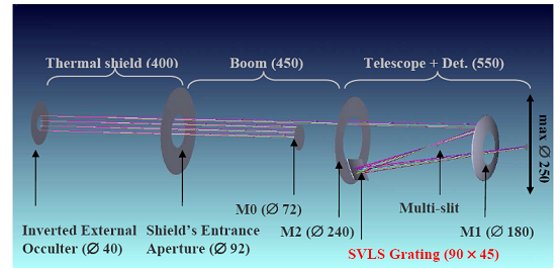Multi Element Telescope for Imaging and Spectroscopy
A coronal imager (ICOR) and spectrograph for the Solar-Orbiter mission
The METIS/ICOR instrument is an inverted-occultation coronagraph currently under design as part of the Solar Orbiter payload. It was selected (for the COR instrument in the model payload) under the PI-ship of E. Antonucci of INAF – Osservatorio Astronomico di Torino, Italy. An augmentation to provide some spectroscopic capabilities is being proposed to ESA.
Science objectives
METIS/ICOR will study the structure and dynamics of the solar corona with unprecedented temporal and spatial resolution at different heights over the ecliptic plane. The instrument is crucial to the Solar Orbiter mission as it provides the needed link between the solar atmosphere and the inner heliosphere. The spectroscopic capabilities, if confirmed, will allow the determination of the line of sight velocity distributions (line profiles) of protons and, for the first time, helium ions between 1.2 and 2 solar radii. This will be crucial for understanding solar wind particle acceleration processes and will put strong constraints on related theories.
![[Top]](/images/icons/top.gif)
The Instrument
The Multi Element Telescope for Imaging and Spectroscopy is an inverted-occultation coronagraph that will image the solar corona in three different wavelengths (visible light between 450 and 650 nm, and the two Lyman-a lines of hydrogen and helium, H I 121.6 nm and He II 30.4 nm) by a combination of multilayer coatings and spectral bandpass filters. The visible channel also includes a polarimeter assembly to observe the linearly polarized component of the K corona. Inclusion of spectroscopic capabilities, which allows us to record spectra of the H I and He II Lyman a lines simultaneously at three different heights (accomplished by a multiple slit) in a 32° sector of the corona, is being proposed to ESA.

|
|
The conceptual design of the METIS instrument: visible light (VL) optical path.
|

|
|
Conceptual layout of the inverted-occultation coronagraph with the insertion of a spherical variable line-space (SVLS) grating. A folding mirror behind M1 is used to select between the visible-light (VL) channel and the VUV channel (H I and He II Lyman a lines imaging and spectroscopy). Dimensions are in mm.
|
![[Top]](/images/icons/top.gif)
MPS contribution
The main MPS contribution consists in providing a focal plane array detector with an active pixel sensor (APS) and its electronic readout system that will be built into the VUV camera.
![[Top]](/images/icons/top.gif)
The Co-I Team
Prof. Dr. Sami K. Solanki (Co-I), Dr. Luca Teriaca (Co-I)
The Engineering Team
Dr. Udo Schühle, Dr. Iancu Pardowitz, Rainer Enge, Stephan Werner
![[Top]](/images/icons/top.gif)
Related links
![[Top]](/images/icons/top.gif)
|
